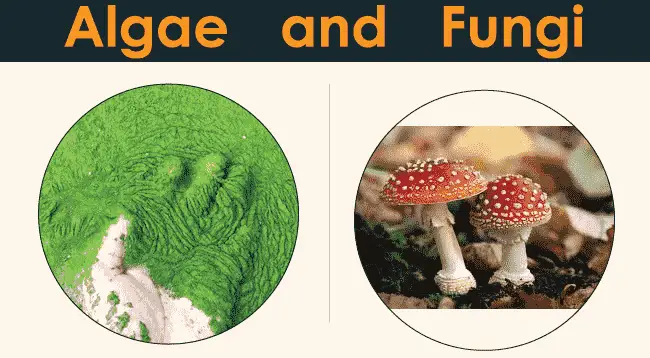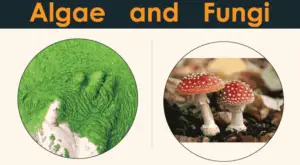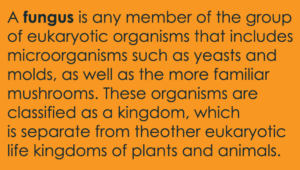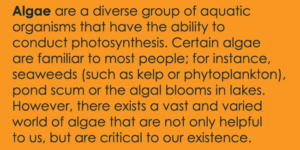
Difference Between Algae and Fungi , You Probably living Confused About These Terms.
The very basic difference between Algae and Fungi is that Algae is photosynthetic While Fungi is non-photosynthetic. Algae is a plant-like organism (but not plant) that often grows inside or near fresh-water bodies. Fungi is a heterotrophic organism that relies on decomposing organisms.

Notice the images above, You probably had seen these somewhere outside.
Let us dive into more detail to have a better overview of the difference between Algae and Fungi.
Difference Between Algae and Mold
| Algae | Fungi | |
| 1. | It is an autotrophic organism. | It is a heterotrophic organism. |
| 2. | It belongs to the kingdom Protista. | It was initially classified into kingdom Protista but due to a large number of its specie, it is then classified into kingdom Fungi. |
| 3. | Its habitat is characterized by aquatic areas as it’s mostly found in marine and freshwater both. | Its habitat is characterized by terrestrial areas as it is found in humid areas, and on dead matters. |
| 4. | These are not able to survive in the dark area. | These are a dark area friendly. |
| 5. | It is found in freshwater. | It is found on land. |
| 6. | It possesses chlorophyll. | It lacks chlorophyll. |
| 7. | Light is a compulsory thing for its survival. | It does not care about light for its survival. |
| 8. | It is either eukaryote or prokaryote. | It is the only eukaryote. |
| 9. | Its cells are uni-nucleated (one nucleus) | It possesses bi-nucleated OR multi-nucleated cells. |
| 10. | Its cell wall is composed of cellulose. | Its cell wall is made of chitin. |
| 11. | Food is reserved in the form of starch. | It reserve food in the form of glucose. |
| 12. | It possesses a filamentous OR parenchymatous body. | It possesses a filamentous OR pseudo-parenchymatous body. |
| 13. | It Is originated from the Latin word which means seaweed. | It Is originated from the Latin word which means mushroom. |
What is Fungi?
What is fungi: it is a multicellular eukaryotic heterotrophic organism that relies on decomposing organic materials on the land. Fungi have its separate kingdom and it can reproduce through sexually as well as asexually. Fungi include molds, mushrooms, rust, smuts, mildews, and yeast, etc.

Classification of fungi:
Fungi exist in 5 classifications that are mentioned below:
- Ascomycota.
- Basidiomycota.
- Chytridiomycota.
- Glomeromycota.
- Zygomycota.
Ascomycota: These are often considered as pathogens to animals and plants including humans as they cause infections like ringworm and ergotism which often cause vomiting, hallucination, convulsions, and death sometimes.
Some Ascomycota often found in humans as Candida Albicans which is a yeast that lives in tracts like in the gastrointestinal and respiratory tract.
‘Asci’ is the name of reproductive sacs that ascomycetes possess.
Basidiomycota: Also a fungal subtype like Ascomycota. Basidiomycota produces spores called basidiospores in the cell and these are sexually products. Basidiomycota also called as club fungi due to the club shape of its cells. mushrooms fall under the category of Basidiomycota.
Chytridiomycota: These are microscopic and are usually aquatic fungi. they asexually produce spores that move using small tail flagella. these are also able to cause infection in frogs by getting under their skin.
Glomeromycota: This classification makes up half of the whole fungi. these often exist in the soil. these form mycorrhizae with mutualism of plants and it is also noted that around 85% of the total land’s plants form mycorrhizae mutually with plants.
Zygomycota: These are terrestrials and consider decaying organics as their feed and are often cause problems by growing on foods that humans use. the very common example of Zygomycota is bread molds that is named as Rhizopus Stolonifer
What is Algae?
Algae is a plant-like, either eukaryotic or prokaryotic organism, that is either unicellular or multicellular, often present on the freshwater surface. It is an autotrophic organism that uses sunlight to carry photosynthesis in order to produce their own food.

One thing to remember that Algae is a plant-like organism but not a plant or we can say that it is near to plant.
I Algae a Type of Mold
Is Algae a Type of Mold
No, algae and mold are two completely different terms, molds are not algae but fungi. Molds can be considered as microscopic fungi category.
Types of Algae are 7 and those are below:
- Chlorophyta.
- Chrysophyta.
- Euglenophyta.
- Pyrrophyta.
- Phaeophyta.
- Rhodophyta.
- Xanthophyta.
Chlorophyta: These are found mostly in fresh-water bodies with very few numbers of species found in the ocean. There are about thousands of species of Chlorophyta that exist. The anatomy of Chlorophyta cell is comprised of the cellulose cell wall and they possess one or two flagella. These are autotrophs as they have chloroplast in their cell and consider the process of photosynthesis
There are further sub-categories of chlorophytes as horsehair algae, deadman’s finger, and sea lettuce. These are multicellular and unicellular and can reproduce by both sexual and asexual methods.
Chrysophyta: It is the abundant type of unicellular algae that possess the color appearance of golden-brown. Chrystophyta has species of around 100,000. It is both salt-water and fresh-water friendly and found in both.
Diatoms are algae type that is more common than the brown-golden and have many more plankton types that are found in the ocean. Diatoms possess outer covering silica instead of a cell wall. Diatoms vary in size, shape, and structure depending on specie type.
Euglenophyta: These are salt & freshwater protists. Some of the euglenoids possess the characteristic of plant cells and are capable of doing fully functional photosynthesis. The euglenoid cell lacks a cell wall and have an outer covering that is made of a protein called pellicle.
Apart from autotroph euglenoids, other euglenoids are heterotrophs and they feed themselves on materials that are carbon-rich inside other unicellular organisms and water. With the photosynthetic characteristic, their physical appearance is comprised of flagella, eyespot, and organelles like the nucleus, vacuoles, and chloroplasts.
Scientists placed photosynthetic euglenoids with green algae as they believe that these organisms with the photosynthetic characteristic is due to the endosymbiotic association with green photosynthetic algae.
Pyrrophyta: It is also known as fire algae that is very commonly found in fresh-water and ocean and can locomote by using their flagella.
They are sub-categorized into two further classes which are known a cryptomonads and dinoflagellates. Dinoflagellates are the one that causes red tidal glowing waves in oceans at night which is a quite interesting and confusing phenomena people consider.
Crypromonads are also a subtype that also causes the ocean water to have appeared red or dark brown and they work almost the same like dinoflagellates.
these both types can be harmful to animals as they secrets neurotoxins which are extremely dangerous for disrupting normal muscle functioning. As these both possess the characteristic of red and glowing this is the reason why they are called fire algae
Phaeophyta: This is also one of the largest algae species that consist a number of seaweed types that are marine environment friendly. They possess specialized tissues and have air pockets in them that help anchor themselves on the water surfaces.
It is noted that phaeophytes have reproductive tissues that employ to produce gametes and spores in them and they also have photosynthetic organs in them.
Rhodophyta: it is eukaryotic red algae that are found in tropical water bodies and they also can grow on solid rocky surfaces.
The cell’s anatomy of the Rhodophytes is comprised of cellulose and many types of carbohydrates containing cell walls and they lack flagella and centrioles.
They use the bi-mode of reproduction by sexually and asexually.
Xanthophyta: These are yellow-green and are a rare type of algae with only around 500 species. Xanthophytes are often found in fresh and saltwater bodies and also in marshy areas.
They are unicellular and their cell’s anatomy consists cell wall made of silica and cellulose and they also contain one or two flagella that assist them to locomote, they possess chloroplast that lacks many pigments which is the reason they appear lighter in color.
Similarities between algae and fungi:
Following are the bunch of tabularized similarities between algae and fungi:
| 1. | Algae and fungi both are considered thallophytes. |
| 2. | With the exception of blue-green algae, all algae and fungi are eukaryotes. |
| 3. | Both can use fragmentation to divide. |
| 4. | Both can take into consideration the process of asexual reproduction. |
| 5. | Both have vascular tissues absent. |
| 6. | Both are considered together in the classification of cryptogams and thallophytes. |
| 7. | Reproductive organs of both do not possess any outer protective covering. |
What are mushrooms?
Mushrooms are sub-category fungi that fall in the phylum ‘Basidiomycota’, it is also characterized by the name toadstool. Mushrooms grow upper the fungal hyphae, are immobile, and prefer to grow on their food source.
What is yeast?
yeasts are unicellular eukaryotes that also fall in the Kingdom fungi. Yeast is called Saccharomyces Cerevisiae that requires moisture, food, and a warm environment to flourish. It transforms the sugars into alcohol in the absence of oxygen by using the process of fermentation or alcoholic fermentation.
Conclusion:
After going through this article we can now conclude that there are many differences between algae and fungi from which few and main are these. However, there are few similarities between these two head terms but they both actually are entirely different living beings. We also studied that there are 5 major types of algae and 7 major types of fungi exist which may further be classified.
FAQ:
What are autotrophs?
Organisms are said to be autotrophs if they acquire energy by using photosynthesis.
What are heterotrophs?
Organisms are said to be heterotrophs if they rely on other organisms to acquire energy.
What are bi-nucleated cells?
Bi means two, so the cells that possess two nucleases are known as bi-nucleated cells.
What is cellulose?
The molecule that is possessing hundreds or thousands of hydrogen, oxygen, and carbon atoms and it is a very commonly founded organic substance in the cell walls of plants.
What is chitin?
it is an organic substance and a glucose derivative that is composed of polysaccharides. It is considered a very major ingredient in fungi cell walls.
What are pathogens?
These are considered extremely harmful microorganisms that can be bacteria, viruses, fungi, or algae.
What is flagella?
Flagella is a tiny tail-like structure that is present at the end of some microorganisms like in some bacteria and algae that help them to locomote.
What is mycorrhizae?
it is a specific association of plant and fungus in which the fungus grows on plant roots. It plays a very major role in the nutrition of the plant the one that is the host of it.
What are chloroplasts?
Chloroplasts are eukaryotic cell organelles that are found in eukaryotic algae and most often in plants. It produces glucose as food for organisms by acquiring the sunlight and water.
What are vacuoles?
These are membrane lined organelles filled with fluid and are residing in the cytosol of the cell.
What is endosymbiosis?
The organisms that live inside other organisms and show parasitic behavior, all this is a phenomena which is known as endosymbiosis.
What are gametes?
Gametes are germ-line cells produced in female organisms. these are produced as the result of sexual reproduction.
What is locomotion?
Locomotion is simple a characteristic or the ability of a creature to shift from one place to another.
What is fragmentation?
It is a type of asexual reproduction in which a parent cell gets divide into sub-cells from the center and those divided cells are considered offsprings.
What are cryptogams?
Cryptogams are organisms or plants that use spore reproduction, are seedless, or flowerless. Cryptogam plants represent plants with no seed.
You may also enjoy reading:
- the difference between archaea and bacteria